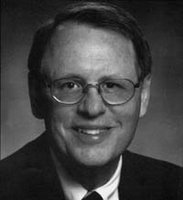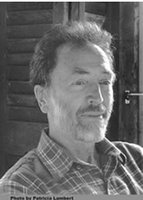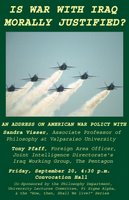JERRI ALLYN LECTURE. SEPTEMBER 16th, 2003Art Never Leaves You Where It Found You: An Introduction Jerri Allyn's vision of art grew out of a profound sense of the need to make art that addresses social problems and builds community.
How I Came to an Interactive View of Art that Focuses on Addressing Social ProblemsI was brought up a Quaker, instilled with a sense of social responsibility and the importance of making a contribution to my community. I was taught to make the world a place that works for everyone.
Along with my Quaker upbringing, I came of age during the social and political upheavals of the 60's and 70's: the civil rights movement, including African-American, Asian, and Latin movements, the peace movement, student movements, woman's movement and the sexual revolution, all of which influenced my thinking. I was introduced to new art forms through feminist artists who broadened the definition of art and questioned whose "voice" is represented. They addressed the questions "What do we want to say as women artists, and to whom do we want to say it?"
Art school had no relationship to the world as I knew it. They taught art history as if it existed in a vacuum with no contextual information about the historical, economic and cultural setting in which art is produced. Studio art classes focused entirely on form and style, which had been the standard teaching technique in studio art for the last fifty years, derived from modernist Bauhaus ideas.
In 1974 change came. Two feminist artists were in residence as professors at the San Francisco Art Institute and they asked us what we wanted to say and to whom did we want to say it? These ideas rocked my world. I had been a good student and worked hard, attending all the recommended art openings where I encountered mostly other artists, teachers from the art institute, and my friends - budding artists. It seemed to me an insulated world.
I had been waitressing my way through art school, and wanted to voice my experiences and the hardships suffered by all working women: how we were treated on the job, how we were stereotyped, the fact that we made thirty-three cents to every dollar a man made (I think we're now up to seventy-four cents), that sexual harassment might have a relationship to the alarming statistics about rape (one out of every three women in the U.S.). To address these issues, I tried new critical strategies and new critical pedagogies based on alternative approaches such as process, interaction, and other conceptual practices. These approaches rejected the traditional production of one-of-a-kind art works sold exclusively to a wealthy, educated elite.
More...Around this time, museums and galleries began to change, becoming public arenas where diverse audiences could look at, interact with, and interpret art for themselves. This contributed to the building of "alternative" art scenes where artists and cultural organizations could speak to their own communities, bringing a targeted audience together around particular issues.
Here is one example of one of my site- specific, interactive installation works. Titled "American Dining: A Working Woman's Moment," it was sponsored by the New Museum of Contemporary Art in New York City. The installation included transformed table-top jukeboxes with a continuous sound collage of humorous stories and music about work, food, money, and stereotypes of women. The flourescent plexi-glass jukeboxes which stood on restaurant tables were accompanied by a set of four artist-designed placemats of different colors, with texts such as “Name That Dame” and “Who are these Famous Food Women?” The installation opened in Gefen's Dairy Restaurant and then moved to five other restaurants in cities across the United States, with cultural sponsors at each site. "American Dining" was based on my real-life experiences waitressing my way through art school, as well as my years with The Waitresses Performance Art collective, of which I was a co-founding member.
The Philosophical and Psychological Bases for this Approach to Art
Twentieth-century developmental education theories pioneered by American Philosopher John Dewey and Swiss philosopher-psychologist Jean Piaget, among others, discovered children are not empty vessels to be filled with knowledge, as traditional pedagogical theory has it, but active builders of knowledge, experimentalists and scientists who are constantly creating and testing their own theories of the world. Progressive education theory now gives young people much greater autonomy to explore the ever-expanding wonders of our universe.
From 1994-98, I did a stint as Director of Education and Public Programs at the Bronx Museum of the Arts, which provided me with a terrific opportunity to study and experiment with educational strategies for introducing contemporary art to new audiences, the community surrounding the Museum, and the NY Metropolitan area to a Museum sometimes thought to be in a maligned borough. Museums have been broadening their outreach to include more than a small percentage of highly educated, cultured elite. By the year 2000, people of color (of various ethnic and economic backgrounds) are close to or comprise more than 50% of urban populations.
These developments are motivated by experiments in new art forms, the interest of museum educators to extend their reach beyond their exhibition galleries, the desire to create a more equitable art world, and efforts to enhance the vitality and economic viability of urban centers in United States. Museum professionals have been discussing these issues for over ten years, often at the annual Association of American Museum conferences, attended yearly by 5000 representatives, including international representation. This organization produced the seminal publication Excellence and Equity: Education and the Public Dimensions of Museums: New Visions: Museums Forging the Future (1992). This publication called for a return to the founding principles of museums in the United States. Some of these principles include:
1. Assuring that the commitment to serve the public is clearly stated in a museum's mission and that education, in the greatest sense, be central to every museum's activity.
2. Reflecting the diversity of our society by establishing and maintaining the broadest possible public dimension for the museum.
3. Enriching our knowledge, understanding, and appreciation of our collections and of the variety of cultures and ideas they represent and evoke.
4. Assuring that the interpretative process manifests a variety of cultural and intellectual perspectives and reflects an appreciation for the diversity of museums' publics.
Examples of this New Style of Interactive Art
TALK BACK! THE COMMUNITY RESPONDS TO THE PERMANENT COLLECTION,
Jerri Allyn with Curator Marysol Nieves & Bank Street College Intern Jessica Harvey, Bronx Museum of the Arts, Education Department in partnership with the Curatorial Department, NY, 1997.
Still unique to Museums, Education and Curatorial Departments designed this exhibit and provided various ways the public could access and engage with prevalent themes raised by artworks in BMA collection. We displayed interpretive responses alongside exhibited artworks. We implemented a design to draw viewers through galleries, including specially designed library tables and an early childhood art desk. A Family Activity Room housed guides with a gallery and at-home activities along with a resource area with literary selections. We facilitated over 25 workshops with community groups that had an ongoing relationship with BMA, from all walks of borough life, aged 7 years to adult. The Education Gallery exhibited graphically designed works and visually provocative responses to the collection by teenagers in Saturday Art and Media School. The closing reception provided an opportunity for the neighborhood to meet and question collection artists.
TOMIE ARIA: Chinese diaspora to the Caribbean and Northeast US. Striking art installation, "Double Happiness," which premiered at The Bronx Museum of the Arts, in partnership with an oral history project at the Museum of the Chinese in the Americas, NY.
This installation explored the Chinese Diaspora to the Americas and Caribbean. The installation took the form of a wedding banquet and was based on a series of oral histories conducted by the artist in various communities throughout the Northeast. "Double Happiness" refers to the Chinese character used in a wedding ceremony to bestow auspicious blessings on the bride and groom, and serves as a metaphor for the bicultural experience of immigrants, a joining and intermingling of families and cultures.
ALYSON POU: Portrait of a neighborhood through understanding changing seasons in a local park, an interactive art project and installation that premiered in The Bronx Museum's Education Gallery, "The Hunter's Moon," NY.
This was a three-month-long evolving installation that followed the transition of the seasons from late summer to autumn and into winter. To capture the essence of place and season, Pou worked with students from a local school to create artworks from natural elements (incorporated in the evolving installation) that created a "portrait" of a Bronx park through the exploration of mythology, history of the site, and the folklore of trees.
JOSELY CARVALHO: Homeless children in US and Brazil
"Cirandas I," 1993; "Segunda Ciranda," 1994
Intar Gallery, NY, USA in conjunction with Museu de Arte Contemporanea de Sao Paulo, Brazil
This project focused on homeless children in the U.S. and Brazil and was developed in collaboration with educators and social Workers. The Brazilian press exposed that their military and police gun down kids on the Street. In response, activist groups taught kids to know their rights and how they can get what they need on their own. In the streets, they have a freedom they would never have at home, yet need to know how to protect themselves, what to do if beat up by police, how they can get schooling, or train in a trade.
The installation consisted of silk-screen on walls, photos, large-screen video projections, hundreds of empty bullets, and coffins. It documented every young person that had been killed by gun violence or abused since birth in Chicago, US (360)- and Rio de Janeiro (469) during 1993. It also presented video taped stories in English and Portuguese, along with statements by young people.
XENOBIA BAILEY: Healing from slavery in the U.S.
"Sistah Paradise Great Walls of Fire Revival Tent" 1993
New Museum of Contemporary Art, NY, 1994
Bronx Museum of the Arts, NY, 1995 in conjunction with Satellite Gallery;
Xenobia Bailey is an African-American craft artist from Seattle, Washington. She redefined her "craft" as Fine Art and began to create installations of crocheted clothes that, worn by Bailey in performance, tell told stories about characters of her invention.
Bailey's ceremonial apron, headpiece and revival tent are all objects that play an important role in the artists tale of Sistah Paradise, a magical African woman who allows herself to be captured and taken into slavery in the United States in order to help free fellow enslaved Africans. By traveling into the deep South and organizing midnight revival meetings, Paradise draws lives together and spirits them back to Africa. Bailey's work developed out of years of experience as a hat-maker, and now her labor-intensive hand-crochet process results in large scale pieces that serve as fanciful reminders of the mystical Sistah Paradise.
 (poster designed by Kate Sullivan)
(poster designed by Kate Sullivan) (poster designed by Kate Sullivan)
(poster designed by Kate Sullivan) Blackboard Link to Sewanee's Online "Conversation on Religion and the Curriculum"
Blackboard Link to Sewanee's Online "Conversation on Religion and the Curriculum"
 Hooking Up, Hanging Out, and Hoping for Mr. Right: College Women on Mating and Dating Today
Hooking Up, Hanging Out, and Hoping for Mr. Right: College Women on Mating and Dating Today Also: A Faculty Panel on "Ethics after the Holocaust." April 8, 4:30 p.m. in the Hearth Room of the Bishop's Common
Also: A Faculty Panel on "Ethics after the Holocaust." April 8, 4:30 p.m. in the Hearth Room of the Bishop's Common
 This event is co-sponsored by the French Department, the University Lectures Committee and the "How, then, Shall We live?" series.
This event is co-sponsored by the French Department, the University Lectures Committee and the "How, then, Shall We live?" series.
 "Is War with Iraq Morally Justified?"
"Is War with Iraq Morally Justified?"